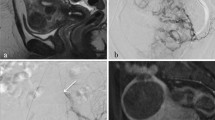Abstract
Purpose
To evaluate the feasibility of using contrast-enhanced ultrasound (CEUS) during uterine artery embolization (UAE) in order to define the correct end-point of embolization with complete devascularization of all fibroids.
Methods
In this prospective study of 10 consecutive women undergoing UAE, CEUS was performed in the angiographic suite during embolization. When the angiographic end-point, defined as the “pruned-tree” appearance of the uterine arteries was reached, CEUS was performed while the angiographic catheters to both uterine arteries were kept in place. The decision whether or not to continue the embolization was based on the findings at CEUS. The results of CEUS were compared with those of contrast-enhanced magnetic resonance imaging (MRI) 1 day as well as 3 months following UAE.
Results
CEUS was successfully performed in all women. In 4 cases injection of particles was continued based on the findings at CEUS despite angiographically complete embolization. CEUS imaging at completion of UAE correlated well with the findings at MRI.
Conclusion
The use of CEUS during UAE is feasible and may increase the quality of UAE.




Similar content being viewed by others
References
Pelage JP, Guaou NG, Jha RC, et al. (2004) Uterine fibroid tumors: Long-term MR imaging outcome after embolization. Radiology 230:803–809
Spies JBM, Allison SM, Flick PM, et al. (2005) Spherical polyvinyl alcohol versus tris-acryl gelatin microspheres for uterine artery embolization for leiomyomas: Results of a limited randomized comparative study. J Vasc Interv Radiol 16:1431–1437
Porter TR, Xie F (1995) Transient myocardial contrast after initial exposure to diagnostic ultrasound pressures with minute doses of intravenously injected microbubbles : Demonstration and potential mechanisms. Circulation 92:2391–2395
Rim SJ, Leong-Poi H, Lindner JR, et al. (2001) Quantification of cerebral perfusion with “real-time” contrast-enhanced ultrasound. Circulation 104:2582–2587
Wei KM, Jayaweera ARP, Firoozan SM, et al. (1998) Quantification of myocardial blood flow with ultrasound-induced destruction of microbubbles administered as a constant venous infusion. Circulation 97:473–483
Marret H, Tranquart F, Sauget S, et al. (2004) Contrast-enhanced sonography during uterine artery embolization for the treatment of leiomyomas. Ultrasound Obstet Gynecol 23:77–79
Pelage JP, Le Dref O, Beregi JP, et al. (2003) Limited uterine artery embolization with tris-acryl gelatin microspheres for uterine fibroids. J Vasc Interv Radiol 14:15–20
Spies JB (2003) Uterine artery embolization for fibroids: Understanding the technical causes of failure. J Vasc Interv Radiol 14:11–14
Dorenberg EJ, Novakovic Z, Smith HJ, et al. (2005) Uterine fibroid embolization can still be improved: Observations on post-procedure magnetic resonance imaging. Acta Radiol 46:547–553
Banovac F, Ascher SM, Jones DA, et al. (2002) Magnetic resonance imaging outcome after uterine artery embolization for leiomyomata with use of tris-acryl gelatin microspheres. J Vasc Interv Radiol 13:681–688
Golzarian J, Lang E, Hovsepian D, Kroncke T, et al. (2006) Higher rate of partial devascularization and clinical failure after uterine artery embolization for fibroids with spherical polyvinyl alcohol. Cardiovasc Intervent Radiol 29:1–3
Nikolic BM, Spies JBM, Abbara SM, et al. (1999) Ovarian artery supply of uterine fibroids as a cause of treatment failure after uterine artery embolization: A case report. J Vasc Interv Radiol 10:1167–1170
Razavi MK, Wolanske KA, Hwang GL, et al. (2002) Angiographic classification of ovarian artery-to-uterine artery anastomoses: Initial observations in uterine fibroid embolization. Radiology 224:707–712
Matthew M, Anthony N, Anna-Maria B (2000) Anastomoses of the ovarian and uterine arteries: A potential pitfall and cause of failure of uterine embolization. Cardiovasc Intervent Radiol 23:393–396
Kim HSM, Tsai JB, Patra AM, et al. (2006) Effects of utero-ovarian anastomoses on clinical outcomes and repeat intervention rates after uterine artery embolization. J Vasc Interv Radiol 17:783–789
Razavi MK, Hwang G, Jahed A, et al. (2003) Abdominal myomectomy versus uterine fibroid embolization in the treatment of symptomatic uterine leiomyomas. AJR Am J Roentgenol 180:1571–1575
Author information
Authors and Affiliations
Corresponding author
Rights and permissions
About this article
Cite this article
Dorenberg, E.J., Jakobsen, J.Å., Brabrand, K. et al. The Feasibility of Contrast-Enhanced Ultrasound During Uterine Artery Embolization: A Pilot Study. Cardiovasc Intervent Radiol 30, 882–887 (2007). https://doi.org/10.1007/s00270-007-9007-8
Published:
Issue Date:
DOI: https://doi.org/10.1007/s00270-007-9007-8




